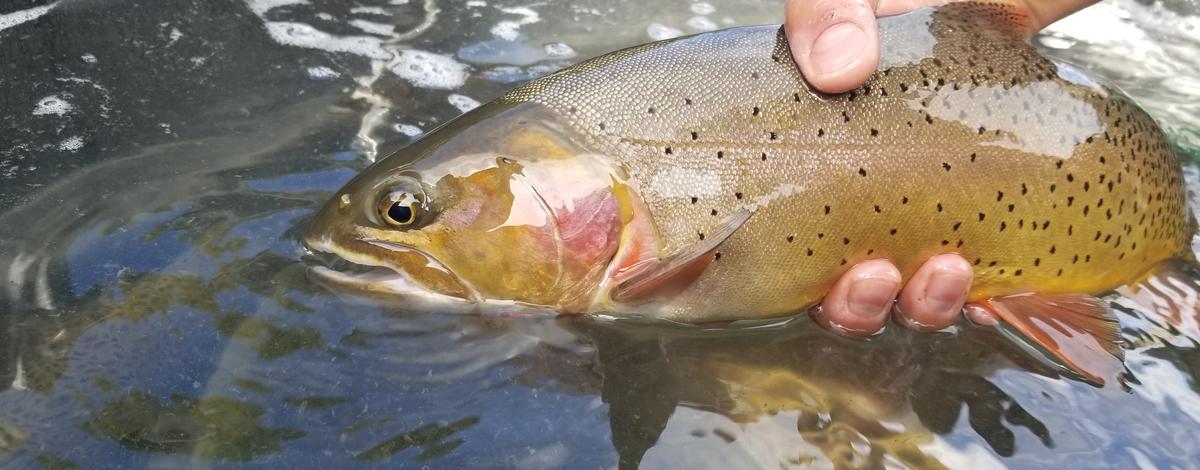The South Fork Snake River (SFSR) supports one of the most robust Yellowstone Cutthroat Trout (YCT) populations throughout the species range. Not surprisingly, the SFSR also has some of the most connected habitat in Idaho for YCT and supports all of the life history patterns of YCT present in the SFSR prior to European settlement. Due to past stocking, Rainbow Trout (RBT) are also found in the SFSR. Rainbow trout differ from YCT in that their native range is more broadly distributed throughout Idaho. Although not native to the Snake River upstream of Shoshone Falls, RBT are naturally found in the Kootenai, Clearwater, Salmon, Wood Rivers and in the Snake River downstream of Shoshone Falls. In contrast, YCT in Idaho are only native to the Snake River upstream of Shoshone Falls. Yellowstone Cutthroat Trout are only found in the intermountain west, whereas Rainbow Trout (RBT) are more widely propagated outside their native range than any other trout in the world. In fact, RBT can be found in every continental U.S. state except Florida.
Both species are in the same taxonomic genus, Oncorhynchus, and spawn near the same time in the spring and have other similar spawning behavior. Because of these similarities, both species can spawn together and successfully reproduce, resulting in hybrid offspring. Hybridization with RBT is the primary threat to YCT throughout their range because historical stocking has broadly distributed RBT across the intermountain west. Unlike the hybrids of other fish species, RBT x YCT hybrids are fertile. Introgression is the transfer of genes from one species into another and can reduce the fitness of the entire population. Through repeated hybridization, the entire population can become highly introgressed where pure YCT are not abundant enough to find one another, resulting in pure YCT reproducing with a hybrid trout producing more hybrid trout. This situation is referred to as a hybrid swarm, when the pure native population is no longer present in measurable numbers due to hybridization with non-native species. An example of a population lost to a hybrid swarm is the Henrys Fork Snake River. Obviously, the loss of the genetic integrity of a robust, native YCT population would raise major concerns about the species as a whole. Additionally, IDFG is bound by its mission statement to “preserve, protect, perpetuate, and manage” the native species of YCT, where there is little concern for the persistence of the RBT as a species.
In the SFSR, hybridization and introgression from RBT has been carefully checked over time using both phenotypic and genetic monitoring. Figure 1 below shows introgression as measured by the number of RBT genes observed in samples of YCT collected in SFSR tributaries over time. The time series below shows that RBT introgression has decreased over time, from highs in the early 2000s between ~7-8% to less than 1% in more recent surveys.


Rainbow Trout introgression has decreased and remained low in SFSR tributaries due to the ability to control RBT spawning in the tributaries via weirs (structures that temporarily inhibit the upstream migration of fish and allow for selective passage of adult trout migrating up to spawn; Figure 2). Beginning in 2001, IDFG constructed weirs on the four major spawning tributaries in the SFSR (Burns, Pine, Rainey, and Palisades creeks). These tributaries are where many of the YCT in the SFSR migrate in the spring to spawn. These weirs are effective at capturing all fish migrating upstream, and allow biologists to use phenotypic characteristics like fin coloration, spotting patterns, and the “cutthroat” jaw slash, to remove RBT and hybrids from the spawning run. Removing RBT and hybrids allows YCT to spawn in isolation from the impacts of hybridization. Accuracy of phenotypic identifications (visually differentiating species) are checked through genetic analyses performed on small, non-lethal fin tissue samples collected from all fish trapped at the weir. Since 2010, 447 Rainbow Trout and hybrids have been removed at these weirs (Table 1), and have been highly successful in preventing hybridization and keeping RBT introgression levels low (Figure 1).

Preserving the genetic integrity of native YCT in the SFSR has been the top management objective for IDFG on the river as directed by the Fisheries Management Plan. In fact, this has been the top management objective for the river since 1996. Introgression with RBT has long been a concern for YCT in the SFSR, but introgression monitoring results, including those above, have indicated efforts to reduce hybridization risks with RBT have been successful. We are hopeful that with sustained management and conservation efforts, YCT will be present in the SFSR with an intact genome for many years to come.

